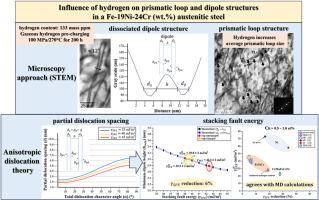Analysis of the influence of hydrogen on prismatic loops and dislocation dipole structure in an austenitic steel: Effect on stacking fault energy
IF 8.3
2区 工程技术
Q1 CHEMISTRY, PHYSICAL
引用次数: 0
Abstract
The influence of hydrogen on crystal defects (point defects and dislocations) determines effects such as hydrogen-induced localized plasticity and damage. One of the structural variables controlling these effects is the stacking fault energy. Experimental and computational studies indicate that hydrogen reduces its value, thereby increasing the partial dislocation spacing, and influencing dislocation behavior. This study quantitatively investigates the influence of solute hydrogen (133 mass ppm) on prismatic loop and dislocation dipole structures in an austenitic steel by an approach based on scanning transmission electron microscopy (STEM) and anisotropic dislocation theory. The established method allows the estimation of the stacking fault energy with greater accuracy than approaches used in the literature. We show that hydrogen leads to several effects on crystal defects, increasing the average prismatic loop size and average dipole height of screw-type dipoles. The analysis of the dissociated dipole structure by a model based on anisotropic dislocation theory indicates that hydrogen reduces the stacking fault energy. We critically compare the present study with former reports in fcc materials and discuss the influence of hydrogen-charging conditions, imaging analysis method, and dislocation theory on the measurement of stacking fault energy. The effect of the present results on the deformation behavior is evaluated.

氢对奥氏体钢棱柱环和位错偶极子结构影响的分析:对层错能的影响
氢对晶体缺陷(点缺陷和位错)的影响决定了氢诱导的局部塑性和损伤等效应。控制这些效应的结构变量之一是层错能。实验和计算研究表明,氢降低了其值,从而增加了部分位错间距,影响了位错行为。采用扫描透射电子显微镜(STEM)和各向异性位错理论,定量研究了溶质氢(133质量ppm)对奥氏体钢棱柱环和位错偶极子结构的影响。所建立的方法使得层错能的估计比文献中使用的方法具有更高的精度。我们发现氢对晶体缺陷的影响,增加了螺旋型偶极子的平均棱柱环尺寸和平均偶极子高度。基于各向异性位错理论的解离偶极子结构分析表明,氢降低了层错能。我们将本研究与fcc材料的先前报道进行了批判性的比较,并讨论了充氢条件、成像分析方法和位错理论对层错能测量的影响。评估了目前的结果对变形行为的影响。
本文章由计算机程序翻译,如有差异,请以英文原文为准。
求助全文
约1分钟内获得全文
求助全文
来源期刊

International Journal of Hydrogen Energy
工程技术-环境科学
CiteScore
13.50
自引率
25.00%
发文量
3502
审稿时长
60 days
期刊介绍:
The objective of the International Journal of Hydrogen Energy is to facilitate the exchange of new ideas, technological advancements, and research findings in the field of Hydrogen Energy among scientists and engineers worldwide. This journal showcases original research, both analytical and experimental, covering various aspects of Hydrogen Energy. These include production, storage, transmission, utilization, enabling technologies, environmental impact, economic considerations, and global perspectives on hydrogen and its carriers such as NH3, CH4, alcohols, etc.
The utilization aspect encompasses various methods such as thermochemical (combustion), photochemical, electrochemical (fuel cells), and nuclear conversion of hydrogen, hydrogen isotopes, and hydrogen carriers into thermal, mechanical, and electrical energies. The applications of these energies can be found in transportation (including aerospace), industrial, commercial, and residential sectors.
 求助内容:
求助内容: 应助结果提醒方式:
应助结果提醒方式:


